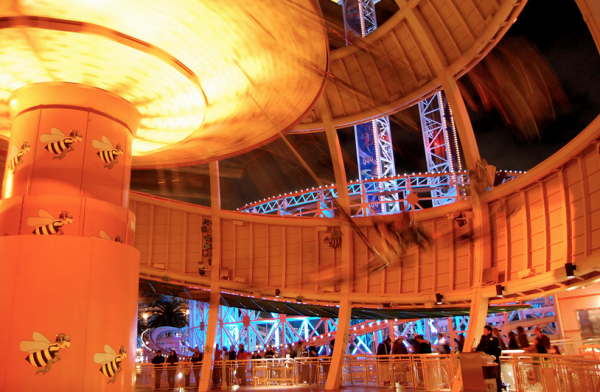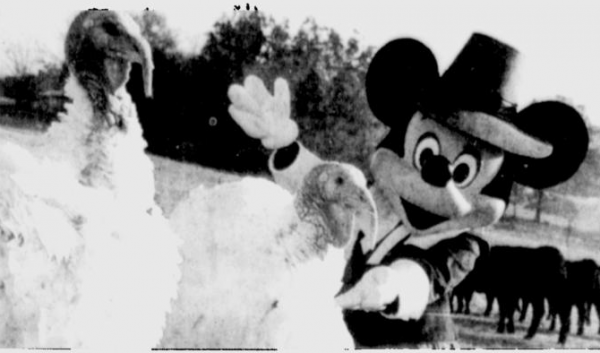Skull Rock
That’s not a name you’d expect to hear at the Happiest Place on Earth. Peter Pan fans recognize it as the lair of Captain Hook. It was, after all, the one place that pirates could call home in Neverland. The introduction of Skull Rock at Disneyland occurred due to a previous decision. Captain Hook’s Pirate Ship aka the Chicken of the Sea Pirate Ship (you were going to guess the Jolly Roger, weren’t you?) debuted with the opening of Disneyland in 1955.
A few years later, Disney decided to accentuate the rest area as a wonderful place for parents to sit and relax while their children played. As the shameless tuna sponsorship indicates, the ship portion was a restaurant. Imagineers constructed Skull Rock as a complementary play spot for kids. It included a suspension bridge and spelunking caves as well as a pirate lookout.
Little explorers could wander the darkened parts of the attraction, running behind waterfalls and battling in imaginary sword duels. In the early days, Skull Rock wasn’t terrible like some of the other attractions listed here. Sure, it was shamelessly commercial, but if that bothers you, Disney isn’t for you anyway. The problem Skull Rock faced was that it was a hastily constructed giant skull that quickly fell into disrepair. The way it looked in 1970 barely compared to its 1960 debut. By the time Disney retired it in 1983, Skull Rock wasn’t a place where you’d happily let your kids play. Instead, it resembled the actual pirate stronghold in terms of cleanliness, and pure authenticity isn’t what you want in a themed land.
More importantly, this attraction violated one of Uncle Walt's core tenets. He stressed that Disneyland should never be finished, demanding that cast members always prioritize the plussing of attractions. With Skull Rock, they looked the other way as the tuna of the sea grew so unsanitary that even the other fish didn't want to eat it.
Orange Stinger
Quick, what’s the best setting for an unforgettable theme park ride? If you’re about to answer “inside a peeled orange,” you are now my sworn enemy. You are also combating the inglorious history of one of Disney’s least successful attractions.
Determining where Disney went wrong isn’t difficult here. They built Disneyland on land previously used as orchard groves. It was literally a part of the heritage. The company rightfully wanted to celebrate the fruit that seeded the grounds of the Happiest Place on Earth. The way they chose to do it…wasn’t ideal.
Disney constructed a five-story tall Orange, hollowing out the interior. Inside, they added a swing ride, the kind that lift riders in the air then swivels them in a gentle circle. What this has to do with citrus fruit is up for debate.
Image: Joe Lewis, Flickr (license)
The reason why this project came into existence is that Michael Eisner wanted to expand Disneyland. His plan to do so involved California theming for the second gate. Lacking in good ideas, they explored cheap ones. An orange tin can with what was basically a carnival ride inside definitely fit the bill. Disney didn’t even waste time in thinking up names. They changed a letter from swinger to stinger and let it be.
Orange Stinger was a debacle from the start. Park planners fitted the ride carts thematically as “bumblebee seats.” Everyone HATED them. After only two days (!) in operation, cast members eliminated them in favor of more conventional swing chairs, ones that took the sting out of the attraction (sorry). It also included the same orange scent made famous by Soarin’. For whatever reason, guests disliked it on a swing ride, so Imagineers eliminated that as well.
While it stayed in operation for eight years, Orange Stinger exemplifies the low-rent perception that Disney California Adventure claimed during its early days. They expected much more from Disney than a cheap carnie ride stuck inside a giant orange.
Happiest Turkeys on Earth
Disney loves the holidays. The official government celebrations consistently rank among the most trafficked park days on the annual calendar. And the company does everything that they can to accentuate the festive events. That philosophy can lead to oddness when it’s not properly kept in check by park planners.
For example, consider the Happiest Turkeys on Earth. In 2005, the 43rd President of the United States, George W. Bush, pardoned a pair of turkeys cruelly named Marshmallow and Yam. It’s the same premise as this scene from The West Wing. On the television show, one turkey earns the pardon, and someone finds out that the other one will wind up as dinner unless something is done. In real life, that’s exactly what happened with Yam. Marshmallow received the pardon, so Yam needed a bit of intervention to survive. Fortunately, the White House interceded and saved both turkeys from a late November dinner table carving.
Image: Disney
Rather than accept permanent residence at an ominous place called Frying Pan Park in Herndon, Virginia, Bush and his staff brokered a deal with The Walt Disney Company. Marshmallow and Yam would become the unlikely honorary grand marshals at Disneyland’s Thanksgiving Day Parade. The birds were transported in first class on an airplane that I’m dead serious when I say was called Turkey One, at least for the day. Once they held such a lofty title, Disney executives couldn’t in good conscience turn around and serve them as giant drumsticks in the days that followed. That’s sad for the bellies of Disneyland guests the following week since Marshmallow and Yam weighed a hefty 72 pounds between them.
Rather than please families as the centerpiece of a meal, Marshmallow and Yam took up residence at Reindeer Round-Up at Big Thunder Ranch. They were a part of the country fair-ish holiday display that ran through the end of the year. They wouldn’t be the last, either. Turkeys with ridiculous names like Pumpkin, Fryer, and Flower would also take up residence at Reindeer Round-Up until 2011. At this point, Disney severed ties with pardoned turkeys. It wasn’t that the attraction was too absurd – although it was. Instead, a problem existed with California law. Why?
Here’s the explanation from the Orange County Register:
“Disney officials recently discovered a little-known federal rule, in the Animal Welfare Act, requiring a 6-foot-high fence around certain animals, including reindeer, in public displays.”
Yes, Disney was illegally stocking turkeys in conditions deemed unsafe by the federal government. The same people who originally provided the company with Marshmallow and Yam didn’t realize they were accidentally causing Disney legal issues. Oops. The other irony here is that the place they deemed unsafe was the sanctuary the turkeys had against Thanksgiving meal consumption.
The moral of the story is simple. Even Disney can’t save turkeys from their Thanksgiving fate forever. Meanwhile, Disney had to save the animal interactions for Walt Disney World.



Comments
I'd never heard of 'Splashtacular' but after reading this really interesting report I might risk speaking out and saying I didn't think it looked too bad, lol!! The idea of a big fan-fare daytime show at Epcot would still be welcome today, maybe?
Great report and thanks for putting it together.